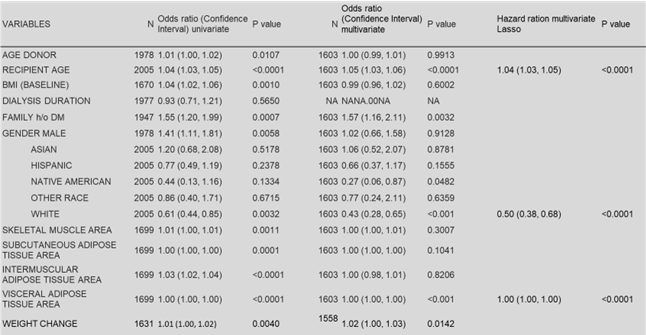Predictive analysis of new-onset diabetes after kidney transplantation: Integrating clinical and radiological factors at Mayo Clinic
Sami Alasfar2, Byron Smith1, Panos Korfiatis3, Timothy Kline3, Aleksandra Kulka1, Pooja Budhiraja2.
1Medicine, Mayo Clinic, Rochester, MN, United States; 2Medicine, Mayo Clinic Arizona, Phoenix, AZ, United States; 3Radiology, Mayo Clinic, Rochester, MN, United States
Introduction: New-Onset Diabetes After Transplantation (NODAT) is a common complication after kidney transplant with an estimated incidence rate of 10-30% at 12 months post-transplant. It is associated with increased risk of infections, graft loss, cardiovascular mortality, and overall mortality. This study aimed to formulate a prediction risk score for NODAT.
Methods: This is a retroseptive study perfomed at the three Mayo Clinic sites: Minnesotta, Arizona, and Florida. The study integrated clinical and radiological data to evaluate the risk of NODAT. Deep learning analyzed pre-transplant CT images for fat quantification and NODAT prediction. A Mayo Clinic model accurately analyzed body composition from CT scans, differentiating various types of adipose tissues and measuring skeletal muscle. Performance was compared with established clinical models. The subjects were selected from 1/2007 to 1/2022 for the Mayo Clinic Arizona cohort. From the other 2 sites, the subjects were included from 1/2014 to 1/2022. The last follow-up was at the end of 1/2023
Results: The study involved 2,005 kidney transplant recipients, with 335 (16.7%) developing NODAT in the first year. The mean age was 52.5 (14.2) years, the mean BMI was 27.4 (6.74) kg/m², and 56.9% were male. Univariate analysis identified risk factors including older age, male gender, baseline BMI, nonwhite race, steroid use, and a family history of Diabetes (Figure 1).

Radiological risk factors of significance on univariate analysis included skeletal muscle area, subcutaneous and visceral adipose tissue area, and intermuscular adipose tissue area. Multivariate analysis revealed that increasing age, nonwhite race, family history of Diabetes, and visceral adipose tissue area were significant predictors. The model using variables such as recipient age, family history of diabetes, race, and visceral adipose tissue area achieved the highest Area Under the Curve (AUC) of 0.7227 for NODAT prediction. Comparison between existing models and different models from this study are shown in figure 2.

Conclusions: This risk score, using pre-transplant data, predicts NODAT risk with high accuracy, enhancing precision medicine through machine learning.
[1] Diabetes
[2] Post Transplant Diabetes
[3] Kidney Transplant
